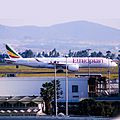Ethiopian Airlines facts for kids

Ethiopian Airlines Airbus A350-900
|
|
| Founded | 21 December 1945 |
|---|---|
| Commenced operations | 8 April 1946 |
| Hubs |
|
| Secondary hubs |
|
| Frequent-flyer program | ShebaMiles |
| Alliance | Star Alliance |
| Subsidiaries |
|
| Fleet size | 156 |
| Destinations |
|
| Parent company | Ethiopian Investment Holdings (100%) |
| Headquarters | Bole International Airport, Addis Ababa, Ethiopia |
| Key people | |
| Revenue | |
| Net income | |
| Profit | |
| Total assets | |
| Total equity | |
| Employees | 18,000 (November 2023) |
Ethiopian Airlines (Amharic: የኢትዮጵያ አየር መንገድ), also known as EAL, is the main airline of Ethiopia. It is fully owned by the Ethiopian government. EAL started on December 21, 1945, and began flying on April 8, 1946. By 1951, it was flying to other countries. In 1965, the company became a share company and changed its name to Ethiopian Airlines.
The airline joined the International Air Transport Association in 1959. It has also been a member of the African Airlines Association since 1968. Ethiopian Airlines became part of the Star Alliance in December 2011. Its slogan is 'The New Spirit of Africa.' The airline's main base and offices are at Bole International Airport in Addis Ababa. From there, it flies to 155 passenger places and 68 cargo places. Ethiopian Airlines is the biggest airline in Africa. It carries the most passengers, flies to the most places, has the largest fleet of planes, and earns the most money. It is also the fourth-largest airline in the world by the number of countries it serves.
Contents
A Look Back: How Ethiopian Airlines Started
The First Flights: 1940s
After Ethiopia was freed, Emperor Haile Selassie I wanted to create an airline. He asked the United States, the United Kingdom, and France for help. The Emperor wanted a good national airline to show that Ethiopia was modernizing. In 1945, the Ethiopian government worked with TWA, an American airline, to set up a new company.
Ethiopian Air Lines (EAL) was officially started on December 21, 1945. The Ethiopian government owned all the shares, but TWA helped manage it. At first, American pilots, technicians, and managers helped run the airline. EAL's first president was Fitawrari Tafasse Habte Mikael. The airline bought five Douglas C-47 planes, which arrived in February 1946.
The first official flight for money was on April 8, 1946. It flew from Addis Ababa to Asmara and then to Cairo. This route became a weekly flight. Soon after, the airline started flying to Aden and Djibouti. It also had a domestic flight to Jimma. By 1949, the airline was making a profit.
Expanding Routes: The 1950s
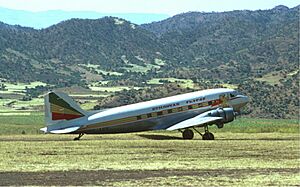
In 1950, EAL got a loan to buy Convair CV-240 planes for international flights. These planes started flying in January 1951 to places like Cairo, Nairobi, and Karachi. By May 1952, the airline had two Convair-240s and nine Douglas DC-3s. Its network of routes was about 7,000 miles long.
A new flight to Athens started in April 1954. In 1955, Ethiopian Airlines opened its own maintenance facility to fix its planes. The airline needed bigger planes, so it ordered two Douglas DC-6Bs in 1956. These planes cost $4 million.
In 1957, a third DC-6B was bought. Flights to two cities in Yemen, Hodeida and Taiz, began in September 1957. By June 1958, Ethiopian Airlines started a new route connecting Addis Ababa and Athens using the DC-6Bs. This route was later extended to Frankfurt and Nairobi. EAL joined the International Air Transport Association (IATA) in January 1959.
Entering the Jet Age: The 1960s and 1970s
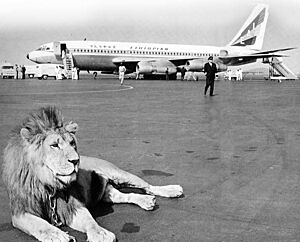
In 1960, the airline had its first serious accident when a DC-3 crashed. This led to investigations into airport conditions. In 1962, two more DC-3s were bought.
A big change happened in December 1962 when Ethiopian Airlines received two Boeing 720B jet planes. This marked the airline's entry into the "jet age." The first jet flight was on January 15, 1963, to Nairobi. Soon after, new jet services started to Madrid and Frankfurt. The airline also built a new airport, Bole International Airport, to handle these larger jet planes.
In 1965, the company officially changed its name from Ethiopian Air Lines to Ethiopian Airlines. By 1971, Ethiopian Airlines was fully managed and staffed by Ethiopian people, without foreign help. In 1978, the airline ordered two Boeing 727s to replace its older Boeing 720s.
Growth and Modernization: The 1980s and 1990s
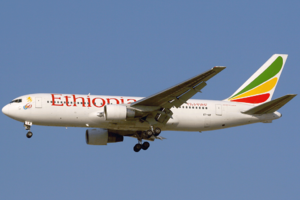
In 1982, Ethiopian Airlines became the first African airline to order the Boeing 767. On June 1, 1984, the first of these planes flew non-stop from Washington, D.C. to Addis Ababa, setting a new distance record for a twin-engine jet. These new planes replaced the older Boeing 720s. Smaller planes like ATR 42s and Twin Otters were added in the mid-1980s. The Boeing 737-200 joined the fleet in late 1987.
In 1991, Ethiopian Airlines was the first passenger airline to receive the Boeing 757 Freighter. By 1996, the airline was flying to many new places, including Bangkok, Beijing, and Johannesburg. The Fokker 50 was added for domestic flights. In the late 1990s, the airline started flying to Copenhagen, Maputo, and transatlantic destinations like New York City and Washington, D.C. Its frequent-flyer program, "ShebaMiles," also began.
Into the New Millennium: 2000 to Today

In the early 2000s, Ethiopian Airlines updated its fleet with Boeing 737-700 and Boeing 767-300ER planes. In the late 2000s, the airline announced it would be the first customer for the Boeing 787 Dreamliner in Africa. It also ordered new Airbus A350-900s, Boeing 777-200LRs, and Bombardier planes.
In September 2010, Ethiopian Airlines was invited to join Star Alliance, a major airline group. It officially became a member in December 2011. This made it the third African airline to join the alliance.
In January 2025, Ethiopian Airlines announced new flights between Addis Ababa and Hyderabad, India. These flights will happen three times a week using Boeing 737 MAX 8 aircraft.
How the Airline Works
Business Success
Ethiopian Airlines has shown strong growth over the years. It has consistently increased its turnover (money earned), number of passengers, and fleet size. For example, in 2008, it had a turnover of $0.97 billion and carried 2.5 million passengers with 35 aircraft. By 2023, its turnover had grown to $6.1 billion, it carried 13.8 million passengers, and had 154 aircraft. This shows how much the airline has expanded and succeeded.
Management and Ownership
The airline is fully owned by the Government of Ethiopia. Even during difficult times, Ethiopian Airlines has been run very professionally. Unlike many other state-owned airlines in Africa, it has focused on business decisions rather than political ones. This has helped it remain successful and profitable.
In 2018, the Ethiopian government announced plans to allow private investors to own parts of state-owned companies, including Ethiopian Airlines. However, the government planned to keep a majority share in key companies like the airline. The current CEO, Mesfin Tasew, was appointed in March 2022. He has worked at Ethiopian Airlines since 1984.
Airline Structure
In July 2017, the Ethiopian government reorganized the airline into a holding group. This was done to make it more efficient and improve customer service. The group includes different parts like:
- The Passenger Airline company
- Cargo Airline and Logistics Company
- Ethiopian Aviation Academy (now a university)
- Ethiopian In-flight Catering Services
- Ethiopian MRO (Maintenance, Repair, and Overhaul) Services
- Ethiopian Hotel and Tourism Services
The MRO Services is the largest of its kind in Africa and the Middle East. The Cargo and Logistical division is growing to handle 1.5 million tons of cargo each year. The Aviation University also opened a second campus for pilot training in 2023.
Head Office
Ethiopian Airlines' main office is at Bole International Airport in Addis Ababa. The airline plans to build a new, larger head office complex. This new building will be constructed on a large plot of land at Bole International Airport.
Goals and Achievements
Ethiopian Airlines has a history of setting and achieving ambitious goals. In 2005, it launched "Vision 2010," aiming to increase passenger traffic to 3 million and revenue to $1 billion by 2010. The airline exceeded all these goals.
In 2010, Ethiopian adopted "Vision 2025," a 15-year plan. It aimed to increase its fleet to 120 planes, destinations to 90, and carry over 18 million passengers. The airline achieved Vision 2025 well ahead of schedule, by 2018. Its fleet grew to 126 planes, and it flew to 127 destinations. Its profit and revenue also reached record highs for an African airline.
Having met its Vision 2025 early, Ethiopian Airlines created an even bigger plan called "Vision 2035." With this plan, the airline aims to almost double its fleet size to 271 planes and increase international destinations to 207. It also plans to carry 65 million passengers and 3 million tons of cargo per year by 2035. The main goal of Vision 2035 is to become one of the top 20 aviation groups in the world.
In 2020, the airline announced plans to build a new $6 billion mega-airport near Bishoftu, south of Addis Ababa. This new airport will be able to handle 100 million passengers a year. Even though the current Bole International Airport was expanded in 2019 to handle 22 million passengers, a new airport is needed for future growth.
In 2023, Ethiopian Airlines made the largest-ever purchase of Boeing airplanes in African history, ordering 67 aircraft. This included Boeing 737 MAX and Boeing 787 Dreamliner planes. It also committed to buying 11 more Airbus A350-900s. In March 2024, Ethiopian Airlines became the first African customer for the Boeing 777X, ordering eight 777-9 passenger aircraft.
Working with Other Companies
Ethiopian Airlines has formed many partnerships to grow its business across Africa.
- In 2013, it bought 49% of the Malawian airline, which became Malawi Airlines.
- In 2018, it partnered with the Zambian government to help restart Zambia Airways, taking a 45% stake. This helps develop Lusaka as a hub for Southern Africa.
- Also in 2018, Ethiopian and its partner ASKY Airlines worked with the Guinean government to create Guinea Airlines. This helps expand air travel in West Africa.
Ethiopian Cargo and Logistics Services also formed a joint company with DHL in 2018. This company, DHL-Ethiopian Airlines Logistics Services S.C., provides ground logistics across Africa. Ethiopian Cargo is building Africa's largest e-commerce hub at Bole International Airport. This hub will handle millions of parcels each year. The airline has also partnered with MailAmericas to develop cross-border e-commerce services.
In 2018, Ethiopian Airlines announced plans for an aerospace manufacturing facility. This new division, a joint venture with Aerosud of South Africa, will design and make aircraft parts. In 2023, the airline signed a deal with Boeing to build a new hangar in Addis Ababa for aircraft parts manufacturing.
In 2021, Ethiopian MRO facility partnered with Israel Aerospace Industries to create a site for converting passenger Boeing 767-300 aircraft into cargo planes. This site is the largest of its kind in Africa. During the COVID-19 pandemic, Ethiopian Airlines temporarily converted about 25 of its passenger planes into freighters to transport COVID-19 vaccines worldwide.
Ethiopian Airlines launched a Mozambican airline, Ethiopian Mozambique Airlines, in December 2018. However, it stopped operations in May 2021 due to a big drop in travel demand from the pandemic.
In January 2021, Ethiopian Airlines signed agreements with South African airlines CemAir and Airlink. These agreements allow passengers to travel with a single ticket and lower fares between different points in their networks.
Where Ethiopian Airlines Flies
As of June 2023, Ethiopian Airlines flies to 133 international and 22 domestic passenger destinations. It also serves 68 cargo destinations. Ethiopian flies to 63 places in Africa, which is more than any other airline. Some of its busiest routes include Addis Ababa to Dubai, Johannesburg, Guangzhou, Nairobi, and Beijing.
The airline has continued to add new destinations. In July 2013, flights to Rio de Janeiro and São Paulo in Brazil began. Flights to Singapore started in December 2013. New services to Shanghai began in March 2014, to Vienna in June 2014, and to Doha in December 2014.
Tokyo-Narita was added in April 2015. Other new destinations include Los Angeles and Dublin. A new service to Manila started in July 2015. The flight from Addis Ababa to Newark via Lomé began in July 2016.
Buenos Aires became the second stop in South America for the airline in March 2018. Cargo destinations have also grown, with new additions like Los Angeles and Mexico City. In March 2018, flights to Nosy-Be in Madagascar and to Kisangani and Mbuji Mayi in the DRC were added. In July 2018, the airline restored service to Asmara, the capital of Eritrea, as relations between Ethiopia and Eritrea improved.
Airline Partnerships
Alliances
In October 2007, Ethiopian Airlines' frequent flyer program, ShebaMiles, partnered with Lufthansa's Miles & More. This allowed members to earn and use miles on both airlines. In July 2008, the airline formed a partnership with ASKY Airlines, based in Lomé, Togo. Ethiopian Airlines owns 40% of ASKY and helps with maintenance and operations. The goal is to make Lomé a regional hub for West Africa. Ethiopian officially joined Star Alliance in December 2011.
Ethiopian Airlines has agreements with many other airlines. These "codeshare agreements" mean that passengers can book flights on one airline but fly on another, making travel easier. Some of these partner airlines include:
- Air Canada
- Air China
- Air India
- All Nippon Airways
- ASKY Airlines
- Austrian Airlines
- EgyptAir
- Etihad Airways (starting July 17, 2025)
- Lufthansa
- Malawi Airlines
- RwandAir
- Saudia
- Singapore Airlines
- South African Airways
- Turkish Airlines
- United Airlines
- Zambia Airways
Planes Ethiopian Airlines Uses
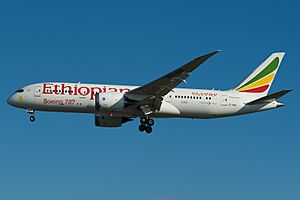
Ethiopian Airlines has been a leader in Africa for ordering and operating new types of aircraft.
- In 2005, it became the first African airline to order the Boeing 787 Dreamliner.
- It was also the first African airline to operate the Boeing 777-200LR.
- In 2016, Ethiopian Airlines was the first African airline to start flying the Airbus A350.
In November 2023, at the Dubai Airshow, Ethiopian Airlines ordered 31 Boeing aircraft, including 20 737 MAXs and 11 787-9s. The airline also ordered 11 more Airbus A350s. In March 2024, Ethiopian Airlines and Boeing announced an agreement for the purchase of eight 777-9 passenger aircraft. This makes Ethiopian the first airline in Africa to order the Boeing 777X. As of 2023, Ethiopian's total aircraft fleet is valued at $5.25 billion, making up about 32% of Africa's total fleet value.
What It's Like to Fly with Ethiopian Airlines
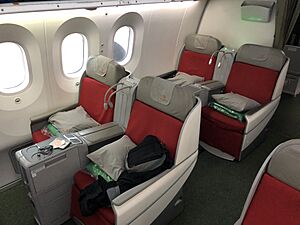
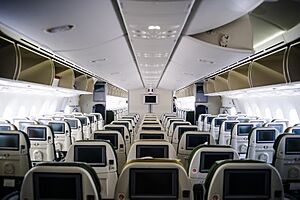
Ethiopian Airlines usually offers two classes on its flights: Cloud Nine (Business Class) and Economy Class. However, some smaller planes like the Bombardier Dash 8 only have Economy Class.
Food and Drinks
On all flights, passengers get free food and drinks. This can be hot meals, snacks, or light refreshments, depending on how long the flight is. Passengers can also buy special drinks. The airline offers different meal options for those with special dietary needs.
In-Flight Entertainment
Cloud Nine (Business Class)
In Cloud Nine, passengers get special amenities and a variety of reading materials. On flights using Boeing 777-200LR planes, there are lie-flat seats and on-demand audio and video with many channels on large screens.
Economy Class
Economy Class passengers receive meals and amenities based on the flight length. On Boeing 777-200LR flights, there are reclining seats and on-demand audio and video with many channels on individual screens.
Lounges
Ethiopian Airlines offers two lounges at Bole International Airport for its passengers. Cloud Nine passengers can relax in the Cloud Nine Lounge, which has various amenities, computers, and Wi-Fi. ShebaMiles cardholders with Gold or Silver status can use the Sheba Miles Lounge. Staff are available at both lounges to help passengers.
Safety Information
According to the Aviation Safety Network, Ethiopian Airlines has had some accidents and incidents over the years. As of March 2019, these events resulted in 494 deaths. The airline works hard to ensure safety for all its flights.
Images for kids
See also
 In Spanish: Ethiopian Airlines para niños
In Spanish: Ethiopian Airlines para niños
- List of airlines of Ethiopia
- Transport in Ethiopia








